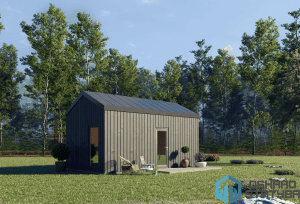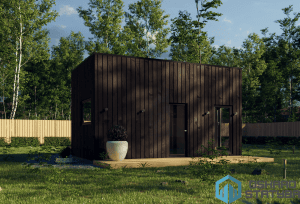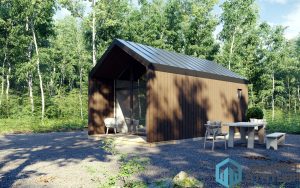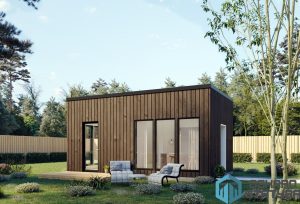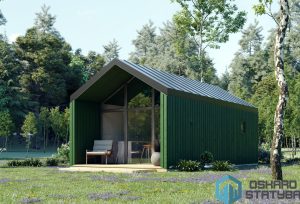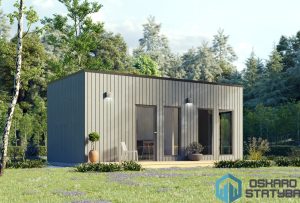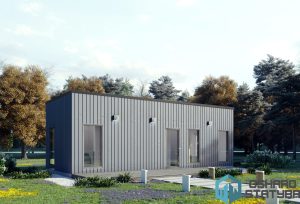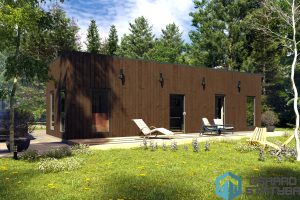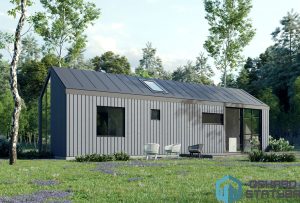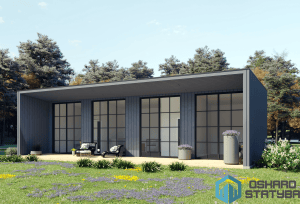In order to effectively insulate mobile homes, it is necessary to choose high-quality insulation materials (expanded polystyrene, mineral wool or ecowool), install a proper ventilation system, and regularly maintain the home’s insulation layer.
Such measures help reduce heat loss and maintain optimal temperatures in mobile homes, ensuring comfort regardless of weather conditions.
Modular homes for sale at Oskarostatyba.lt are fully insulated and ready for year-round living.
If you are seriously considering purchasing a garden shed, contact us to discuss your expectations. We will advise you, prepare a complete project, and build the shed in just a few months.
Oskarostatyba.lt mobile homes – main features:
- Effective thermal insulation : up to 30cm thick insulation for walls, roof and floors ensures warmth and comfort in the room even on the coldest days.
- Reliable heating system : Air-to-air heat pumps and other solutions provide the house with heat all year round.
- Faster construction : Mobile garden houses are built using prefabricated modules in a workshop, so they are built much faster than a traditional house.
- Customized solutions : The ability to customize the house project according to the client’s personal needs and preferences.
- Lower construction cost : Standardized components and pre-fabrication of modules in the workshop significantly reduce the overall cost of the project.
What materials are best suited for insulating mobile homes?
The three most popular materials for insulating garden sheds are:
- Expanded polystyrene : This material is lightweight and has excellent insulating properties, making it a common material for insulating walls, floors, and roofs of mobile homes. Expanded polystyrene is effective at reducing heat loss, but it is not very resistant to moisture, which can be a problem in humid or rainy areas. When building a project in such an area, additional waterproofing layers may be required to protect the insulation from moisture.
- Mineral wool : This is one of the most popular insulation materials, the main advantages of which are fire resistance and good sound insulation. Mineral wool is also highly resistant to moisture, making it ideal for use in mobile homes built in humid climates. Although this material is somewhat heavier and may cost more, its durability and effectiveness in thermal and sound insulation justify this investment.
- Ecowool : Ecowool, made from recycled materials, is an environmentally friendly option that is gaining popularity. This material is a good insulator and is breathable, which helps regulate indoor air quality and reduce the risk of condensation. However, this material requires very careful installation to avoid air gaps, which can reduce the effectiveness of the insulation in the room. It will also require more maintenance to maintain its properties over time.
Methods and techniques for effective insulation
External insulation
External insulation is a method where insulating materials are installed on the exterior walls, floor, or roof of a house.
This insulation method effectively reduces heat loss because the external insulation creates a continuous protective layer around the entire house. This avoids thermal bridges, which often form between insulation layers and structural elements.
In addition, external insulation does not take up interior space, so the practicality of the house does not decrease.
However, it is important to note that this method of insulation can change the external appearance of the house, so aesthetic aspects should be assessed before implementing the project.
Internal insulation
Internal insulation is the process of installing insulation on the interior walls, ceilings, or floors of a home. This method allows you to preserve the existing aesthetics of the home, as no insulation materials are installed on the outside.
Internal insulation is ideal for quick and inexpensive improvements to thermal efficiency, as it requires fewer structural changes. However, it is worth noting that this insulation method can slightly reduce the internal space of the house, especially if thicker insulation materials are used.
This insulation method also requires greater care when installing the insulation to avoid the formation of air gaps.
How to choose the right insulation materials?
- Climate conditions :
- It is important to consider the climate in which the mobile home will be built. In cold regions, a thicker insulation layer (at least 150-200 mm thick) should be chosen to ensure that the home retains heat during the winter.
- Type of insulation materials :
- Expanded polystyrene : Less moisture resistant; more suitable for dry climates.
- Mineral wool : Fire and moisture resistant; ideal for regions with high humidity levels.
- Ecowool : Environmentally friendly, regulates indoor microclimate well; requires careful installation and greater maintenance.
- Use of the cottage :
- If the house will be used regularly, even during the cold season, it is important to choose high-quality, thicker materials that retain heat well all year round.
- Installation complexity and cost :
- It is important to estimate how much time and resources will be required to install the insulation. For example, ecowool will require professional installation, while expanded polystyrene, although easier and faster to install, may require additional finishing work.
Mobile home insulation challenges and solutions
| Challenge | Solution method |
| Condensation formation | Install a proper ventilation system that ensures constant air circulation and reduces moisture buildup. |
| Mold spread | Use vapor barriers that prevent moisture from entering the insulation materials and thus creating favorable conditions for mold. |
| Decomposition of materials | Prepare surfaces before installing insulation: ensure walls, floors and roof are dry and clean. |
| Decrease in insulation efficiency | Check and, if necessary, renew the insulation material regularly, especially before the cold season. |
| Ensuring the durability of insulation | When choosing insulation materials, consider their resistance to UV rays, moisture and mechanical stress. |



